

We may earn revenue from the products available on this page and participate in affiliate programs. Learn More ›
While there are many advantages to putting up an artificial Christmas trees, purists will say that there’s nothing like the real thing (and nothing that smells quite as good). In fact, the National Christmas Tree Association reports that 22.34 million real Christmas trees were purchased in the U.S. in 2022.
With so many folks eager to get a jump on Christmas decorating, it’s important to know just how long a real Christmas tree will last you—you don’t want to put it up too early only for it to be on its way out by December 25.
Don Tapio, owner of Christmas Valley Tree Farm in Rochester, Washington, says you can absolutely expect your tree to last the whole season, which is about 4 weeks, if you give the tree some TLC.
“Almost all trees, if well taken care of, will last through the holiday season,” he says. But, Tapio adds, the key to getting it to go the distance is selecting a healthy tree. Here’s how to pick out a tree that will still be going strong when Santa slides down the chimney.
4 Tips for Getting a Christmas Tree That Lasts
1. Ask when the tree was cut down.
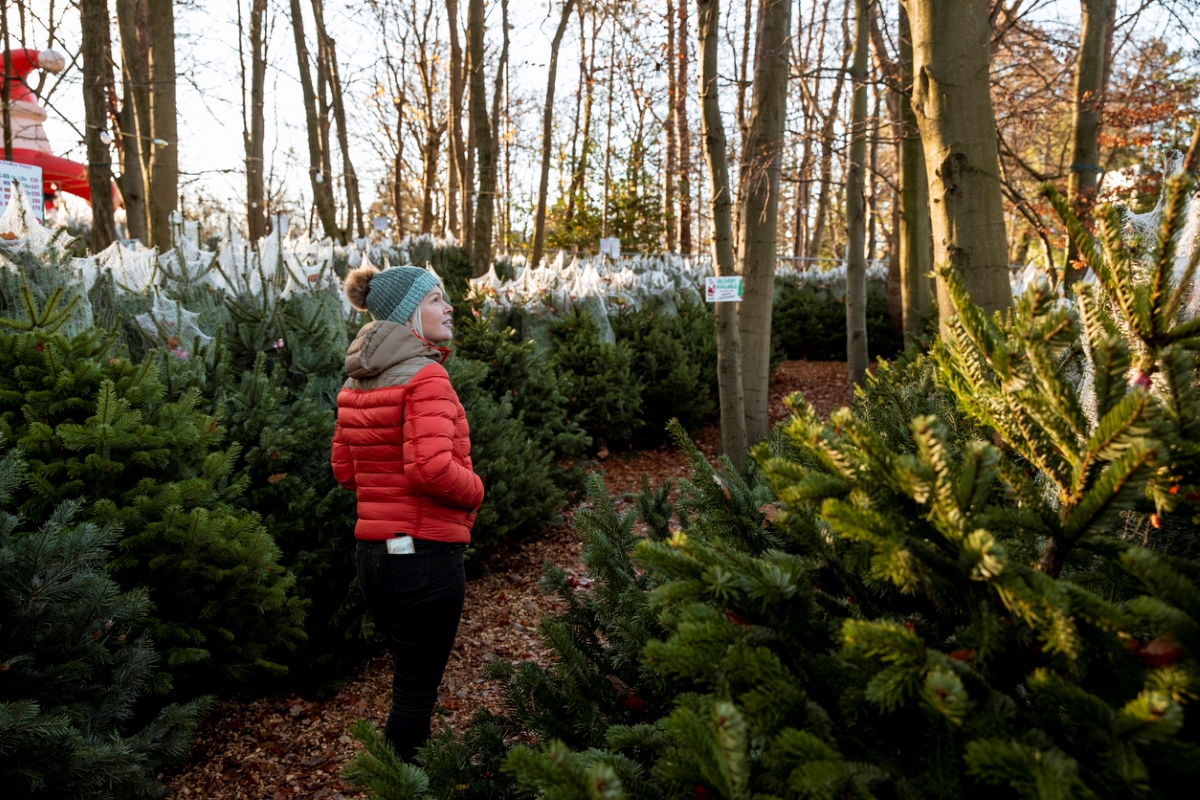
Christmas trees are cut from mid-November to mid-December, so don’t assume that all of the trees you find at the lot were freshly cut. If you’re buying a precut tree, ask when the trees on the lot were felled. Choose one that came down recently (within the week, if possible) so that it will look fresh through the season.
2. Opt for fir or cypress species over spruce or pine.
How long a real Christmas tree lasts varies depending on the specific tree’s species. Most often, Christmas trees at tree farms or local home and garden centers are fir, cypress, pine, and spruce. While all four are evergreen conifers, fir and cypress tend to keep most of their needles for 4 or 5 weeks, respectively, whereas pine and spruce are more likely to lose a high volume of needles within 2 or 3 weeks, respectively.
3. Inspect the tree’s needles before taking it home.
As you make your selection, give each prospective tree a good shake and observe the volume and color of the needles that fall off. “You would not want to bring home a tree that has apparent needle loss or a lot of brown needles,” says Tapio. Only a few brown needles should come off if the tree is fresh; numerous fallen green needles are a telltale sign that the tree has already gone dry. Tapio also suggests testing the pliability of the needles. “If you bend them and they flex easily, that’s a good sign,” he says. “But if you touch them and they break or aren’t flexible, that indicates the tree is dehydrated.”
RELATED: 7 Ways to Keep Christmas Tree Needles from Taking Over Your Home
4. Ask to have the Christmas tree baled before putting it in your car.
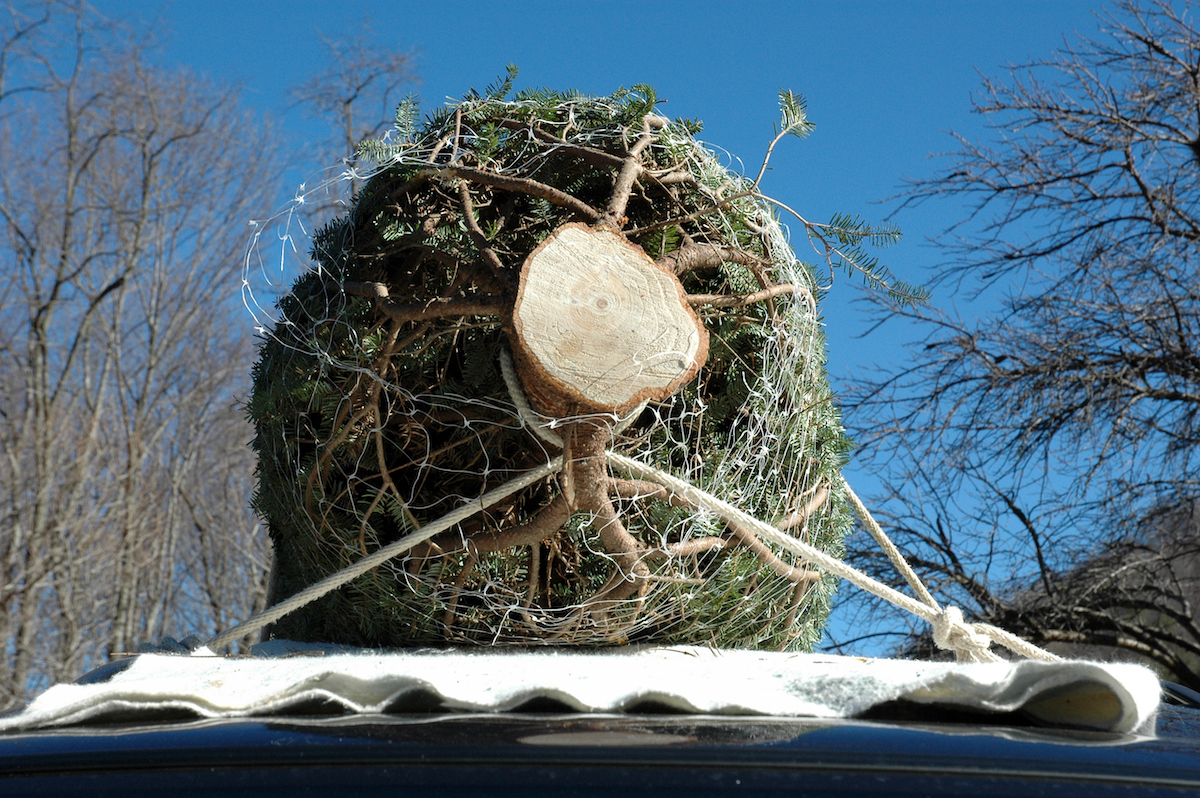
Many folks transport unbundled Christmas trees inside a truck cargo bed only to arrive home to find numerous bent branches and mounds of fallen needles. If you’ll be hauling your tree home yourself rather than having it delivered, ask to have it put through a tree baler, which will wrap it in protective netting or twine and condense it for transport without damaging the trunk or branches. If you’re driving home in a car (as opposed to a truck), securely tie the baled tree to the roof racks with rope or twine. Remove the netting once you have inserted the base of the trunk in your tree stand.
How to Care For a Christmas Tree Once It’s Home
Choosing the tree and getting it safely home is only half the battle in terms of Christmas tree care. The next challenge is figuring out how to keep the tree alive until the holidays are over. You’ll get the best
1. Unseal the tree’s trunk before submerging it in water.
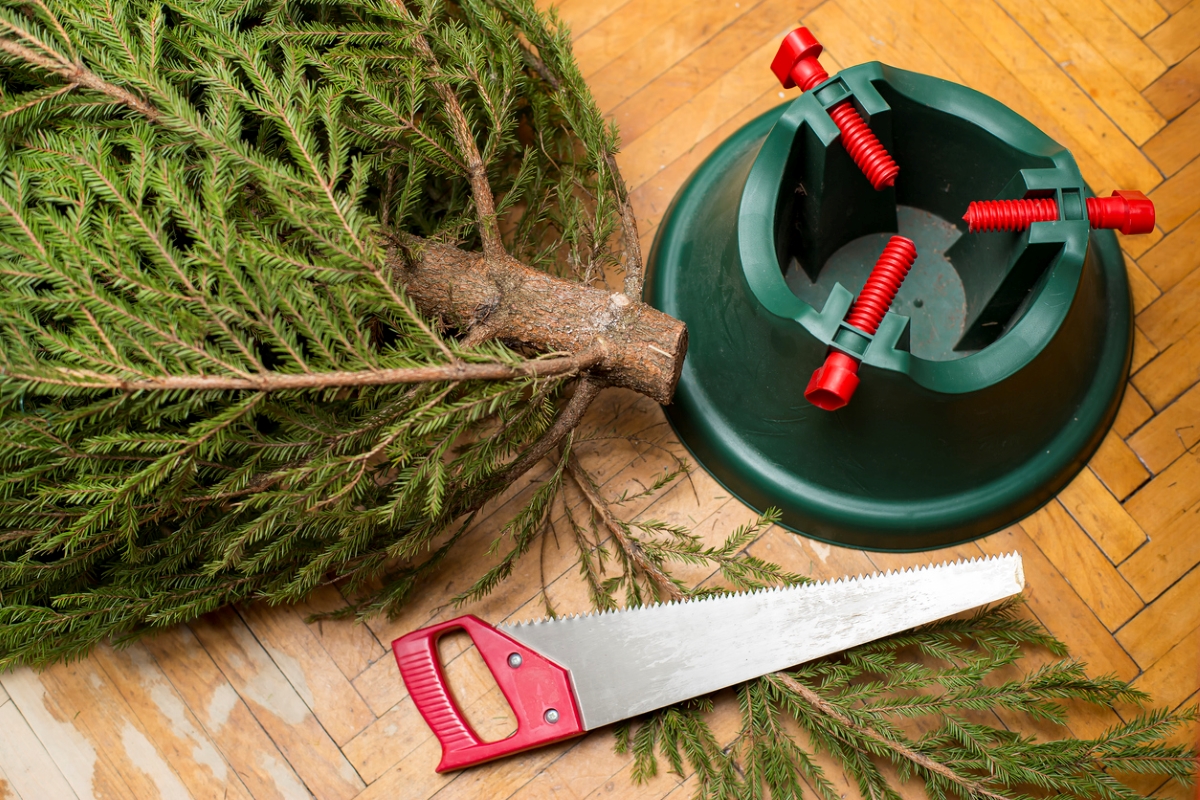
If your tree was cut more than 6 to 8 hours ago, a layer of resin will have formed over the cells of the wood at the base of the trunk, sealing it and impeding water uptake. If you ask at the tree lot, enthusiastic helpers will typically take a little bit off the trunk while they’re baling the tree. If they won’t, or if it’s been more than 6 to 8 hours since they did, you’ll need to take action. “When you first get home with your tree, resaw the butt end,” says Tapio, so that the tree’s cells are open and can absorb water. “Your cut can be as thin as a slice of bologna, but it’s important to slice off a bit” of the trunk, he says. “Don’t cut the trunk at an angle or into a V shape,” he cautions. “An angle cut will require more water depth to cover the cut surface.”
2. Get the tree in water as soon as possible.
After you’ve cut the trunk, it’s possible you might not have the time or the inclination to get the tree in the stand and start decorating right away. If you aren’t ready to trim the tree just yet, place it in a full bucket of water. “A tree will use up to a gallon of water the first day you bring it home,” says Tapio, so top off the water as needed.
RELATED: The Most Eco-Friendly Christmas Tree of All? A Living One
3. Use a sturdy tree stand that holds plenty of water.
Your stand should fit the tree properly and hold at least a gallon of water. Check the stand regularly to make sure that the water level has not dropped below the base of the tree. The Krinner Tree Genie XXL, the top pick in our researched guide to the best Christmas tree stands, holds 2.5 gallons of water and can accommodate trees up to 12 feet tall.
4. Don’t add anything to the tree water.
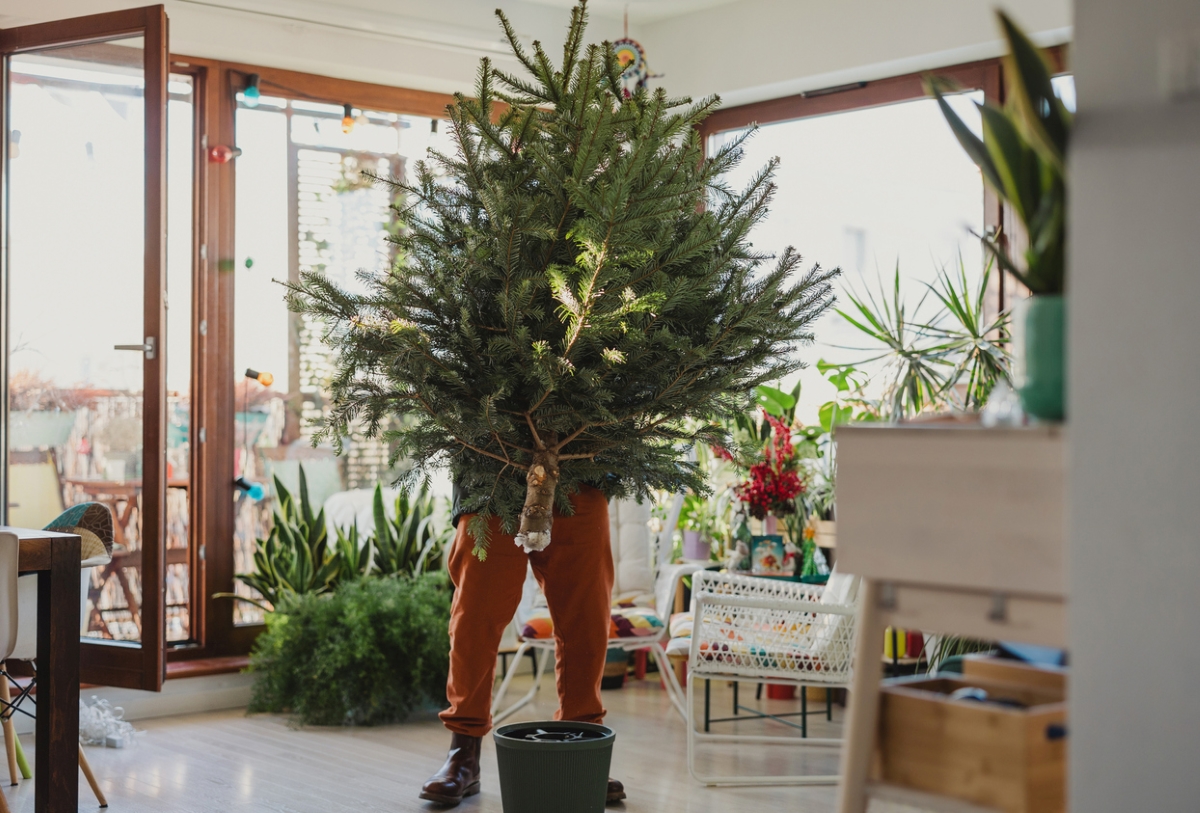
- Insert the trunk in a metal, plastic, or concrete reservoir-style tree stand and straighten the tree in the stand.
- Fill the reservoir to capacity with cool tap water.
- Don’t be tempted by “preservatives.” Homeowners have laced the water in their tree stands with everything from floral preservatives to powdered bleach and crushed aspirin to keep their trees fresh. You may even have read about using sugar water for Christmas trees. However, says Tapio, “Research has been done by Christmas tree specialists across the country, and they have found that the best thing is just plain water.” Eschew the potions and feed the sugar water to the hummingbirds—tap water is all that’s needed to quench your tree’s thirst.
RELATED: The Best Rotating Christmas Tree Stands for a Festive Display
5. Keep the tree cool and out of direct sunlight.
To preserve your tree’s moist needles and vivid green hue, situate the tannenbaum indoors, ideally in a room that’s no warmer than 70 degrees Fahrenheit.
“Lowering the room temperature will slow the drying process, resulting in less water consumption each day,” says Tapio. “Keep displayed trees away from sources of heat, such as fireplaces, heaters, heat vents, and direct sunlight,” he suggests. The heat from these sources can prematurely dry out and brown your tree.
6. Check the water level daily.
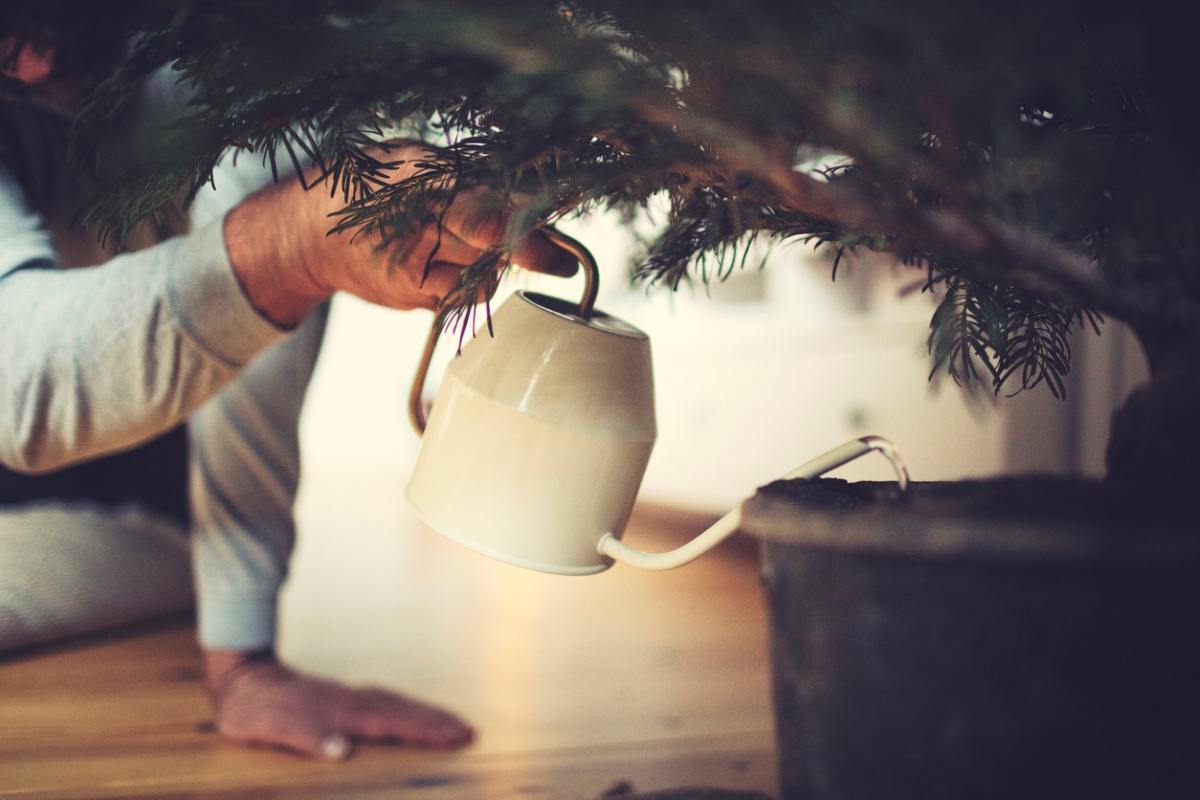
Learning how to water a Christmas tree properly is mostly just a matter of making sure the reservoir in the tree stand doesn’t run dry. Monitor the reservoir’s water level daily, and add more Christmas tree water as needed to keep the bottom 2 inches of trunk submerged. “One thing people don’t think about, if they have pets, is that Fido or Fifi often decides the Christmas tree stand is a wonderful place to get a drink of water,” says Tapio, and the pets drain the reservoir, unbeknownst to the homeowner. “If the reservoir around your tree’s trunk runs dry, it will form a scab that will help it hold the water it already contains but prevent it from drinking more water,” he explains. “Once the tree stops drinking water, it will begin to dry out.”
In your quest to figure out how to keep a Christmas tree alive, you may want to purchase a moisture level monitor like the Evergreen Elf, which mounts on the tree stand and automatically detects the water level in the reservoir. It will light up or send audio signals when the water level is low so you’ll know it’s time for a refill.
RELATED: Christmas Miracle: 8 Simple Fixes for All Your Tree Troubles
7. Use miniature LED tree lights, rather than large incandescent bulbs.
LED Christmas lights, particularly miniature lights (5 millimeters in length), generate less heat than larger, incandescent bulbs and can reduce drying so your tree may stay fresh and green longer. Bonus: LED lights use less energy.
